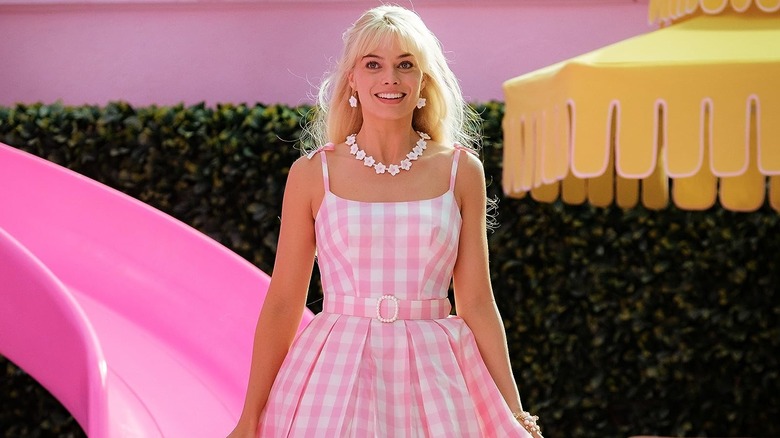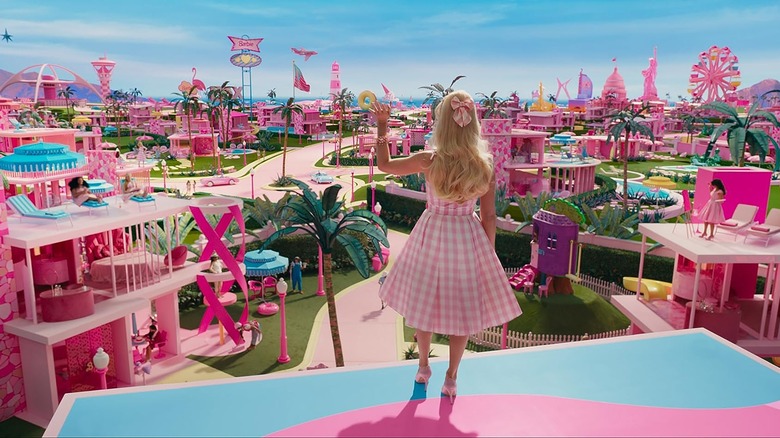How Greta Gerwig's Barbie Put A Wes Anderson Technique To Good Use
One of the many things to admire about director Greta Gerwig's "Barbie" is its commitment to eschewing realism. At no point do Gerwig and her production team attempt to make the film's fantastical scenery feel even remotely "real," be it the boldly-colored scenery for Stereotypical Barbie (Margot Robbie) and Ken's (Ryan Gosling) homes in Barbieland or the silent-era practical effects used for the montage of Barbie and Ken traveling over deserts, across oceans, and even into space on their way to the real world.
Of course, if there's one modern director who's synonymous with favoring formalism — making it a point to call attention to the "formal" or technical aspects of filmmaking like "Barbie" does — over realism, it would have to be Wes Anderson. The auteur behind films like "Asteroid City," "The Grand Budapest Hotel," and "The Royal Tenenbaums" avoids photoreal CGI as much as possible, preferring to instead rely on old-school miniatures, stop-motion animation, and other tactile forms of cinematic trickery. He also loves to have characters break the fourth wall (be it through dialogue or even physically within his actual movies), often using symmetrical compositions and keeping his camera ever steady to further emphasize the artificiality of what you're seeing. His worlds are just as meticulously constructed within the frame, with nary a prop or miscellaneous object out of place.
Anderson's maximalist aesthetic is more than just style for its own sake, however. His visuals tell us a lot about the characters in his films in ways that would come off feeling tedious if you tried to get the same ideas across via dialogue, including who they are and how they live their day-to-day lives. It's this element of his artistry, in particular, that Gerwig kept in mind as she went about constructing the world(s) of "Barbie."
The emotions of Barbieland
Speaking to Film Comment, Gerwig explained how she handled the transition from directing modestly budgeted, visually grounded films like "Lady Bird" and "Little Women" to tackling "Barbie," a $145 million behemoth in which just about every frame is packed full of objects, colors, and just plain ol' stuff:
"I thought about that a lot while making the movie, and there are many other filmmakers you can use as an example for this, but the one that sprung to my mind was Wes Anderson and his constructed worlds. For him the objects are emotional, and the sets are emotional. There are the emotions of the characters, and then there are the emotions of the inanimate objects. That was something I wanted to tap into."
Gerwig's comment calls attention to another key component of Anderson's aesthetic. The carefully designed worlds in his films often stand in stark contrast to their characters, most of whom are typically in the middle of an emotional crisis (be they grieving the death of a loved one, stuck in a dysfunctional relationship, or dealing with the ennui that comes with a specific age). Such is also the case with "Barbie," a film that's all about Stereotypical Barbie having a sudden existential crisis that's completely removed from the perfect plastic paradise she calls home. Thanks to the deliberately heightened design of her surroundings, the character's raw emotions stand out in a way that they wouldn't have otherwise.
In the end, "Barbie" is all about its namesake reckoning with her emotional turmoil and forgoing her picture-perfect existence in order to embrace the inherent messiness of real life. It's the type of emotion-driven conclusion that would absolutely feel at home in one of Anderson's own off-beat, quirky creations.

